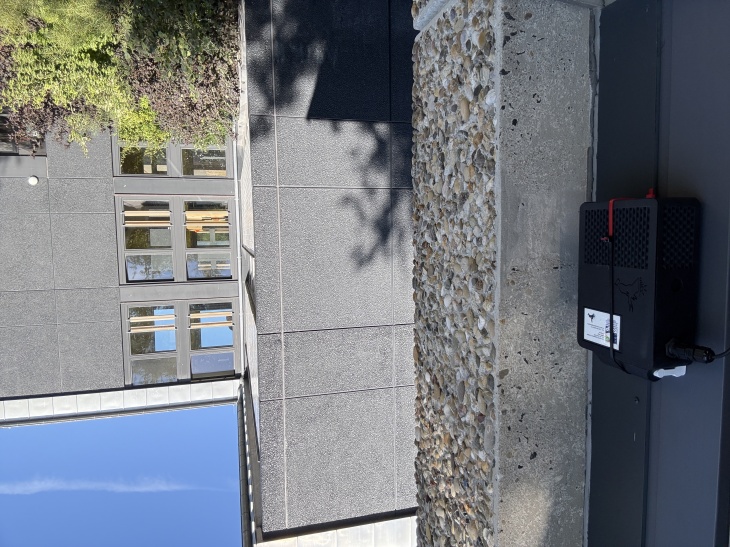Air in the classroom and on the schoolyard
At the start of the new school year, researchers from the Helmholtz-Zentrum Hereon launched a year-long measurement campaign at the Bergedorf district school in Hamburg. The goal is to precisely monitor air quality, including fine particulate matter and gases, both on the school grounds and inside the classrooms. Students and teachers are actively involved in the project Monétisation d’un Air Meilleur / Monetization of a Better Air (MAMBA). The collected data will be analyzed in collaboration with European partner institutions and integrated into environmental models. This aims to deepen the understanding of air pollution and help identify effective countermeasures.

The measuring devices were installed both inside and outside the school building. Photo: Hereon/ Rabea Osol
The initiative was sparked by a personal connection: children of researchers from the Hereon Institute of Coastal Environmental Chemistry attend the Bergedorf district school. This led to an exchange with teachers — and eventually to the idea of a collaboration. What makes the project particularly exciting for the researchers is the comparison between outdoor and indoor air. The collected data can also be applied to other buildings. Until now, no comparable air quality measurements had been conducted in Bergedorf.
"A school is an ideal environment because many factors can be clearly observed here: usage versus non-usage, air exchange, architectural features. What happens over the weekend? What happens at night? The nuances matter," says Hereon scientist Dr Martin Ramacher. Twelfth-grade students in the school’s science track are regularly updated on the measurement results and are also invited to visit the Hereon student lab Quantensprung.
Inside and outside

Hereon researcher Dr Martin Ramacher explained his work to the students.
Photo: Hereon/ Rabea Osol
Lead scientists Dr Volker Matthias and Dr Martin Ramacher, together with the students, have installed a total of 13 measuring devices. The small black boxes, roughly the size of an old handheld radio, are now positioned in various locations: the teachers' lounge, classrooms, stairwells, the gymnasium, and the cafeteria. Additional units are placed in the schoolyard and on windowsills. This setup ensures a well-balanced mix of measurements from both modern and older buildings, as well as multiple outdoor sites. The sensors record data every minute, capturing levels of carbon dioxide, nitric oxide, nitrogen dioxide, ozone, fine particulate matter of various sizes, volatile organic compounds, as well as temperature, air pressure, and humidity.
The interaction between indoor and outdoor air is still poorly understood — in most scientific studies, these two environments are examined separately. This is where the MAMBA project, in collaboration with partners from Belgium and France, comes in.
“The devices were developed by the Institut Scientifique de Service Public in Liège, or ISSeP for short,” says Volker Matthias, head of the Hereon Chemistry Transport Modeling department.
“Air pollution is often underestimated. It not only contributes to respiratory illnesses but also increases the risk of cancer and diabetes. Fine particulate matter is especially critical.” Once the campaign is complete, the local measurement data will be used to further develop and validate cross-site models for indoor and outdoor air. The overarching goal is to enable a holistic assessment of air quality.
Cutting-edge research for a changing world
Helmholtz-Zentrum Hereon`s scientific research aims at preserving a world worth living in. To this end, around 1000 employees generate knowledge and research new technologies for greater resilience and sustainability - for the benefit of the climate, the coast and people. The path from idea to innovation leads through a continuous interplay between experimental studies, modeling and AI to digital twins that map the diverse parameters of climate and coast or human biology in the computer. This is an interdisciplinary approach that spans from the fundamental scientific understanding of complex systems to scenarios and practical applications. As an active member of national and international research networks and the Helmholtz Association, Hereon supports politics, business and society in shaping a sustainable future by transferring the expertise it has gained.
Contact & further Links
Scientist
Institute of Coastal Environmental Chemistry
Phone: +49 (0)4152 87 – 2346
